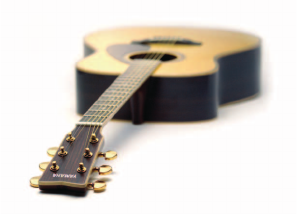
Caring For Your Yamaha Guitar
Wood is a living material, and this fine acoustic instrument, being made from
wood, will naturally react to changes in humidity, by contracting and expanding.
For this reason, humidification is a very important issue in caring for your guitar.
When making guitars we pay very close attention to the wood’s moisture content,
carefully managing it throughout the entire manufacturing process. After
purchasing the wood, we allow it to dry naturally until its moisture content
reaches 12% to 13%. The wood is then moved into a seasoning room where
further drying brings the moisture content down to a level somewhere between
6% and 8%. From this point we start manufacture of the instrument, and maintain
moisture content at 8% until the instrument is complete, to keep the wood
stable all through production. So, after creating an instrument in optimum
conditions such as these, we ask that you, the owner of this fine instrument,
consider the environment in which you keep your guitar and provide it with
adequate humidification.
When the guitar is not being used, keep it in its hard case, and store it in a
location that varies little in temperature, has a low humidity level, and is not
exposed to direct sunlight. Optimum humidity in the room should be between
40% and 50%. In areas or seasons in which humidity is low, we recommend
that a humidifier be used to control the humidity. If you do choose to use a
humidifier for this reason, please control the humidity level carefully.
Sudden variations in temperature or humidity can cause irreparable damage to
the guitar. Never leave the guitar in an automobile for a long period of time,
likewise never leave the instrument in the car trunk. And when traveling by air
we recommend that the instrument be carried onto the plane rather than
checking it in as baggage at the counter.
Taking the time to follow the advice given above will extend the life and ensure
the quality of your guitar.
* Please be forewarned.
You may notice a white, powder-like substance in the finish on the instrument’s rosewood
sides or back. This is lime found naturally in the wood’s grain (from the soil in which the
tree grew) and it will not have any effect on the instrument’s sound or quality.
Caring for your guitar’s lacquer finish
(#36 models)
The lacquer coating is thin and delicate making it an optimum finish for fine
instruments such as this guitar. However, the finish is susceptible to changes in
temperature, humidity, and the handling of the instrument.
To keep your guitar both looking and sounding beautiful for as long as possible,
please pay close attention to the following points.
1Do not place the guitar directly onto the rubber cushions often found on guitar stands,
etc. Such contact can damage the lacquered surface. If such a stand is used, place some
cloth over the rubber cushions to prevent contact between the rubber and guitar’s surface.
2When storing the instrument in its hard case, place a few packets of silica gel inside the
case and store the case in a location where it will not be exposed to direct sunlight. Also,
storing the instrument in the hard case for long periods of time is not advised. Open up
the case occasionally to let the air circulate through the case.
1
2
5 6
07.1.15, 9:11 PMPage 8-9









